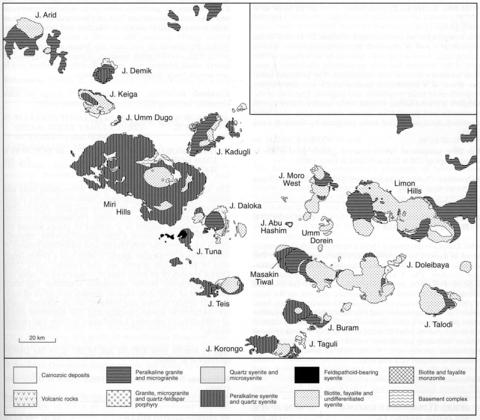stripes
These are a rugged group of hills rising to 500 m above the plain with widespread outcrops of basement rocks along the flanks, which are locally fenitized. There are several patches of volcanic rocks, principally rhyolites, but there are also some trachytic lavas and a range of felsic breccias. The intrusive rocks are nearly all peralkaline and range from syenite through quartz syenite to granite. Curtis and Brinkmann (1985) have divided the complex, on a strucural basis, into four separate bodies and there are a number of ring features that in places appear to show an easterly progression of intrusion. The syenites vary from types with calcic-sodic amphiboles and clinopyroxenes showing some sodium enrichment in the rims to more peralkaline varieties with sodic amphibole which may be marginally replaced by aegirine. These rocks grade into granites the mafic phase of which is predominantly aegirine, but varieties in which sodic amphibole is predominant also occur. Pegmatites of aegirine granite are relatively common; zircon is a common accessory and fluorite occasional. In the peralkaline granites at the western end of the complex a number of fracture zones have been mineralized including introduction of aegirine, bastnasite (up to 2% of the rock), zircon and fluorite. Analyses of four rocks are given by Curtis and Lenz (1985).
CURTIS, P. and BRINKMANN, K. 1985. The geology of younger intrusive alkali complexes in the southwestern Nuba Mountains, Sudan. Geologisches Jahrbuch, 63: 3-41.CURTIS, P. and LENZ, H. 1985. Geological and geochronological investigations of selected alkali igneous complexes in the Nuba Mountains, southern Kordofan, Sudan. Geologisches Jahrbuch, 69: 3-24.

